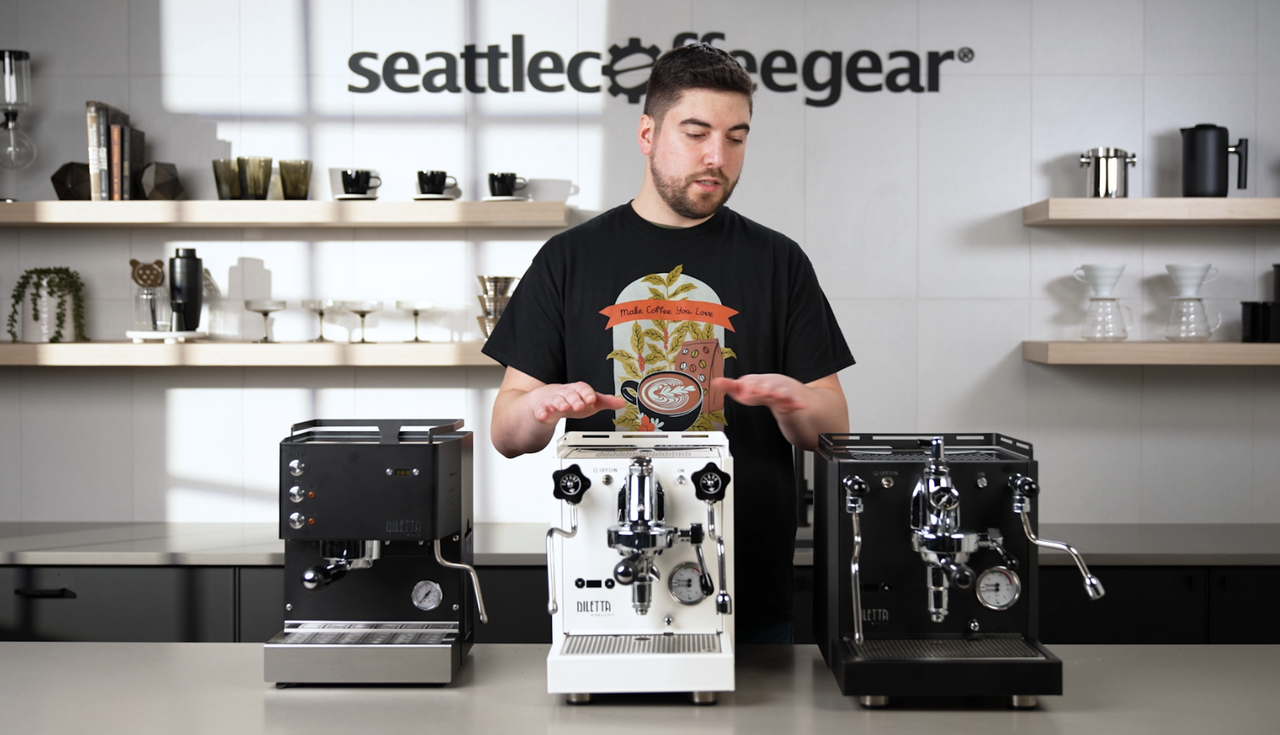There's a lot of different features to think about when purchasing a home espresso machine, but there's a few things that are more important than fancy touch screens and swanky color ways (though we love those too)! Today we want to outline a few key elements of espresso machines that you should consider first when picking one out for your countertop. We should note - today we're discussing semi-automatic machines specifically, but some of these concepts apply to superautomatic espresso machines as well.
Dose and Volume Control
The first feature we want to discuss is dose/volume control and programming. As you might already know, espresso shots are pulled with a ratio of water to coffee in mind. Many new users will work with a ratio of 1:2 coffee to water. This means that you'll grind, say, 14 grams of beans and then pull a shot with 28 grams of water. One major convenience for home espresso machines is programming that allows you to set a volume like this on a button so that you just have to press it and it will stop pumping automatically at the desired volume.
Some machines handle this type of programming by weight and include a scale built into the machine, or another type of flow meter, though these tend to be higher end features. Really all that you need to fulfill this type of need is a time based programming option that you then set yourself when you dial in. Many entry level machines have this feature, and some higher end machines are lacking it, but we can confirm that it's absolutely something worth paying a little extra for especially when starting out, as it'll help you brew more consistent shots. If anything, when you consider an upgrade you will probably be skilled enough to pull your shots with less programming and more manual control.
Temperature Control
The next feature we want to cover is temperature control. Coffee is almost always brewed between 195 and 205 degrees Fahrenheit. While there are plenty of machines out there that don't offer temp control that stay within this range, they can be a challenge for newer and users to operate. With solid temperature control you will be able to count on your machine to deliver the steam and hot water when you want it without any extra hassle.
Typically the kind of thing you're looking for is something with PID controlled temperatures. A PID controller is a computer chip that algorithmically regulates the machine's heating element, ensuring that water stays at a steady temp. This differs from a standard thermostat, which will usually wait for water to drop to a certain temperature and then turn on the heating element, causing a lag time. Even if you leave the machine set at a steady temp, a PID controller will help prevent that lag time and let you be sure that any issues with your shots are not coming from water temp problems.
Ease of Maintenance
The last major feature we want to discuss today is maintenance. As Jake points out in our video below, proper maintenance goes a long way towards ensuring delicious shots. Some machines require you to just know when they need descaling or maintenance, and many don't come with clear guidelines for the actual technique to keep it clean. When shopping for your first machine your best move is to get something with indicator lights or some sort of visual interface that can alert you to when and what kind of maintenance is required. It's also worth considering a machine that has proprietary water filters. Though these proprietary filters are an added expense and may feel superfluous, they really do help improve the longevity of your machine, even if you use filtered water to brew.
Regardless of what kind of machine you go with, it's extremely important to read the manual and understand the maintenance schedule, that way your machine will keep brewing tasty shots for years and years.
While there are other things to think about when picking out an espresso machine, using the features above as a baseline is a good thing to keep in mind while you shop. Of course, if you are a more experienced user you might be able to skip some of these things if you're already comfortable pulling shots.
For more thoughts on these concepts you can check out our video below, and be sure to leave a comment with any questions or advice of your own!


